Discovery of 7 exoplanets around a Sun-like star
Another flash on Jupiter
August 22, 2010SETI REU students 2010 – "This is the end…"
September 8, 2010Today, a team of astronomers from Europe led by group of the Observatoire de Geneve announced the discovery of SEVEN exoplanets around a southern hemisphere star called HD 10180. Even if the name of the star is far from being memorable, our community will remember this major leap in the quest of exoplanets.
What do we know about the host star?
With a declination of -60 degrees (see Vizier), HD10180 is definitely visible in the southern hemisphere. The star is 127 light-years away in the southern constellation of Hydrus (the Male Water Snake)and has a visual magnitude of 7.3, which makes it barely visible with naked eye. It is quite similar to our sun in temperature and size, but also in age (estimated to 4.3 Gyrs).
The embedded video below (credit: ESO) is zoom sequence which starts with a wide-field view of the southern sky, including the Magellanic Clouds. It gradually closes in on the apparently unremarkable star HD 10180 in the little-known constellation of Hydrus.
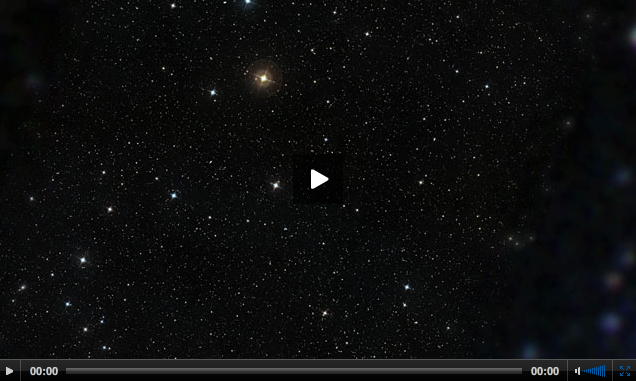
What about the exoplanets?
Using HARPS spectrograph on the 3.6m telescope at ESO-La Silla, the team recorded 190 observations of this star. Over 6 years of observations, they have been able to measure the wobbling of the star due to the motion of the exoplanets and detected them with an accuracy of 1 m/s (slower than the speed of a walker). The five strongest signals (6.5 m/s of dispersion) correspond to the presence of exoplanets with Neptune-like masses orbiting the star with periods ranging from about 6 to 600 days. These planets are located between 0.06 and 1.4 times the Earth–Sun distance (Astronomical Unit, or AU) from their central star. For comparison Mercury orbits around the sun at 0.39 AU and the Mars at 1.52 AU.
As mentioned in their submitted article, they improved their model by adding in their analysis one Saturn-mass exoplanet orbiting in 2,200 days so at 3.4 AU and one small terrestrial planet (1.4 Earth mass) orbiting at 0.02 AU from its star.
To illustrate their analysis I am attaching below a figure from their research article (Lovis et al., A&A, 2010) which shows the radial velocity time series and the plot performed using a model of 7 planets. The bottom figure indicates the low residuals with a global rms of 1.33 m/s.
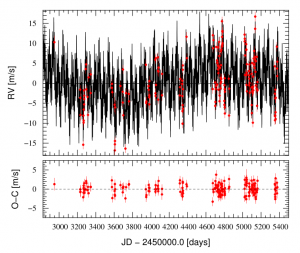
Radial velocity time series with the 7-Keplerian model overplotted. The lower panel shows the low residuals to the model (from C. Lovis et al, A&A, 2010)
On the existence of multiple planetary systems
We know today 15 planetary systems with at least 3 exoplanets. HD 10180 is somehow a unique system. Its five Neptune-like planets lie within a distance equivalent to the orbit of Mars, so it is more populated than our Solar System, most likely a multi-body migration process is needed to explain this observation . The system has probably no gas giant like Jupiter since none was detected at less than 10 AU from the star. Finally, the presence of this hot and rocky exoplanet at proximity to its star represents a new class of exoplanets that seems to be common (see the figure below)
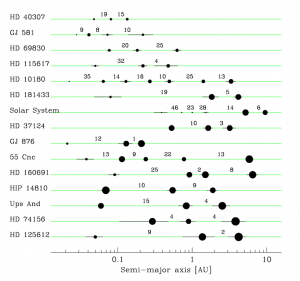
The 15 planetary systems with at least three known planets as of May 2010. The numbers give the minimal distance between adjacent planets expressed in mutual Hill radii. Planet sizes are proportional to log (m sin i). (Lovis etal. A&A 2010)
Astronomers from the California and Carnegie Planet Search team announced in November 2007 the discovery of a fifth planet around the nearby star 55 Cancri. Almost three years later, astronomers are now able to detect planetary systems with 7 exoplanets. This progress is definitely due the improve sensitivity of our instruments but also because we have a longer time baseline to detect exoplanets far from their star. For instance, HD 10180 g is orbiting around HD10180 in ~600 days so multiple years of surveys, like this one, are needed to detect such a long trend.
The artistic picture below show the 7-planet system of HD10180 seen from the third planet in the system ( a Neptune-like planet). Two exoplanets, a Neptune-like and an Earth-like, are shown transiting their star, 3 other Neptune-like planets and the Saturn-like planets are drawn in the background. Like our solar system, these exoplanets describe coplanar and almost circular orbits around their star.
The article contains as well an interesting discussion on a possible Extrasolar Titius-Bode-like law and the metallicity of the stars which are known to host exoplanets.
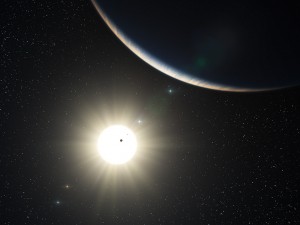
This artist’s impression shows the remarkable planetary system around the Sun-like star HD 10180. The large crescent is the third world in the system (HD 10180d), which is comparable to the planet Neptune in mass. The two inner planets appear as silhouettes in transit across the bright disc of the star. The outer planets in the system appear in the background sky.(Credit ESO)
This discovery is also a good news for space telescopes like Corot or Kepler which are looking for terrestrial exoplanets. The existence of H10180b (the hot rocky world) may suggest that there are a lot of these worlds in our galaxy.
I heard that Kepler is preparing an announcement for this week on Thursday, I am betting that they indeed already found one of these worlds :-).
more soon!
F.
PS: I am now on Twitter. @AllPlanets
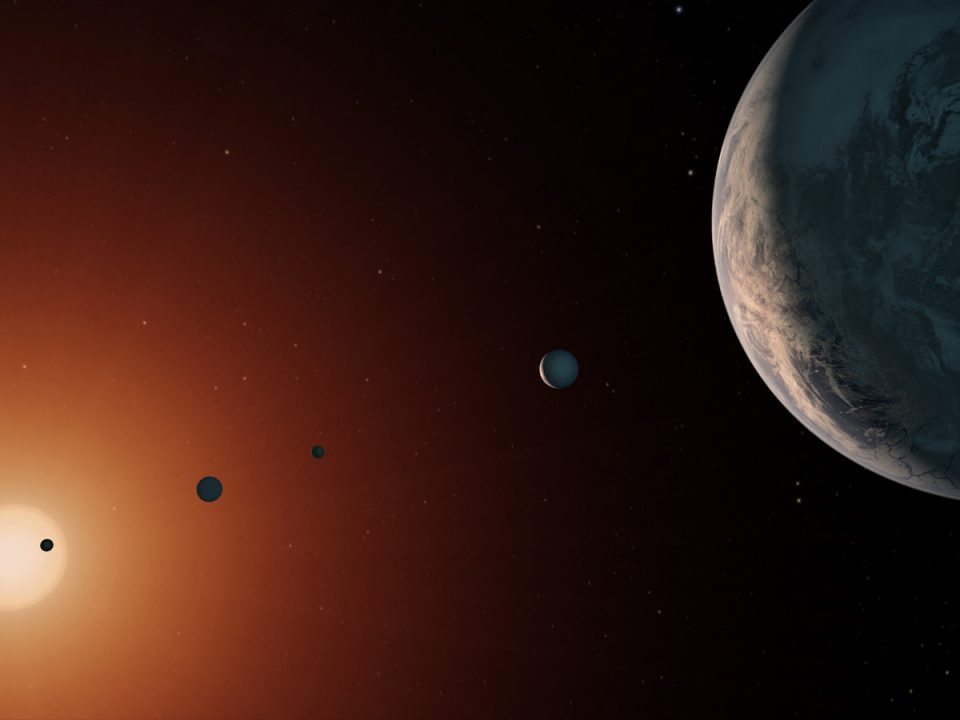
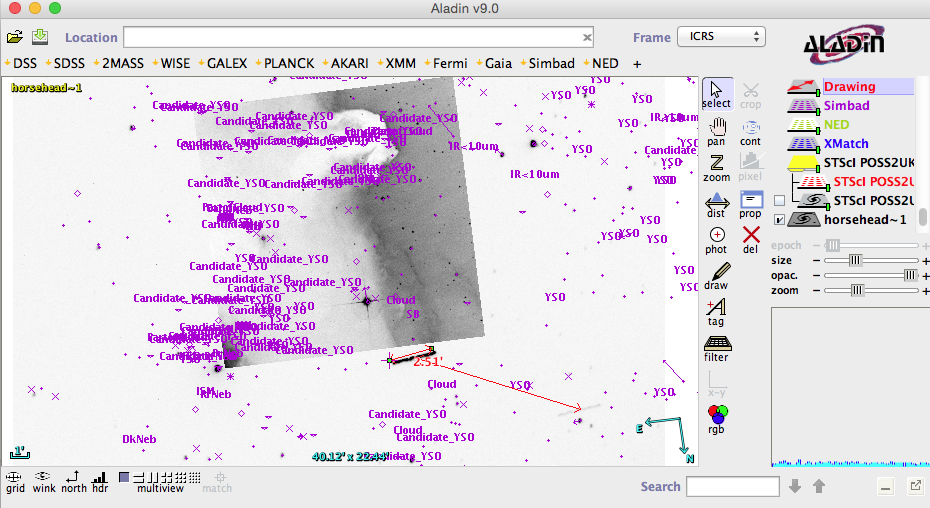
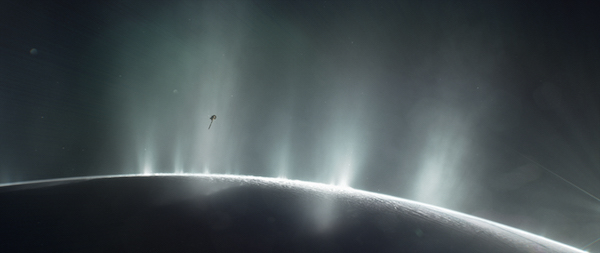
7 Comments
Wonderful ….. but how do they select the stars they observe?
They generally choose the inactive (Main sequence stars) and bright stars (F,G,K type). avoiding young stars with a lot of stellar activity (noise).
Congratulations to all the folks involved!
Superluminous (ie. beyond merely brilliant) news. I love heraing about tehse new found worlds of other suns and love seeing the animation zooming in on the star as well. Thanks & well done!
What’s the spectral & luminosity class of this star btw?
Is there any chance it will actually get a memorable english name as opposed to just a ctalogue number even if just a descriptive name like “the Seven-World Star”?
I can’t see that anywhere in the article above – sorry if I’ve missed it.
BTW. I’m wondering about Beta Hydri in the same constellation – it is a nearby (24 ly) sun-like subgiant G2 IV star – has that been examined for exoplanets and has anything been found orbiting it? (Source : Kaler’s Stars website – Beta Hydri page – not sure if I can add links here so I won’t & earlier Dole, Stephen, & Asimov, Isaac, ‘Planets for Man’, New York, Random House, 1964.)
From Simbad (link Vizier in my post) http://simbad.u-strasbg.fr/simbad/sim-id?Ident=HD10180&NbIdent=1&Radius=2&Radius.unit=arcmin&submit=submit+id
C.D.S. – SIMBAD4 rel 1.160 – 2010.08.25CEST15:46:45
HD10180
——-
Object HD 10180 — * — OID=@3196609 (@@73737,18) — coobox=23326
Coordinates(ICRS,ep=2000,eq=2000): 01 37 53.5763 -60 30 41.499 (~) A [5.43 4.56 38] 1997A&A…323L..49P
Coordinates(FK5,ep=2000,eq=2000): 01 37 53.576 -60 30 41.50
Coordinates(FK4,ep=1950,eq=1950): 01 36 08.60 -60 45 55.4
Coordinates(Gal,ep=2000,eq=2000): 292.8054 -55.6940
Proper motions: -14.92 6.17 [0.62 0.53 41] A 1997A&A…323L..49P
Parallax: 25.39 [0.62] A 1997A&A…323L..49P
Radial Velocity: 35.2 [0.1] D 2004A&A…418..989N
Redshift: 0.000117 [0.000000] D 2004A&A…418..989N
cz: 35.20 [0.10] D 2004A&A…418..989N
Flux B : 7.92 [~] D ~
Flux V : 7.33 [~] D ~
Flux J : 6.246 [0.021] C 2003yCat.2246….0C
Flux H : 5.934 [0.031] C 2003yCat.2246….0C
Flux K : 5.868 [0.018] C 2003yCat.2246….0C
Spectral type: G1V ~ ~
Morphological type: ~ ~ ~
Angular size: ~ ~ ~ (~) ~ ~ ~
Identifiers (16):
HD 10180 CD-61 285 CPC 20.1 322
CPD-61 124 GC 1984 GSC 08850-01715
HIC 7599 HIP 7599 2MASS J01375356-6030414
PPM 352502 SAO 248411 SKY# 2452
SPOCS 88 SRS 3926 TYC 8850-1715-1
uvby98 100010180
Bibcodes 1850-2009 () (20):
2009A&A…501..941H 2009ApJ…700.1794B 2008A&A…487..373S 2008ApJ…682.1234B
2007ApJS..168..297T 2006A&A…450..735M 2006A&A…458..873S 2006AJ….132..161G
2006AstL…32..759G 2006MNRAS.370..163B 2006MNRAS.372..163J 2005ApJ…622.1102F
2005ApJS..159..141V 2004A&A…418..989N 2002MNRAS.332..759T 2002MNRAS.337.1170J
1998MNRAS.298..332R 1996AJ….111..439H 1994A&AS..106..257O 1980ApJS…44….1T
Measures (Fe_H:1 Hbet1:2 MK:2 oRV:1 PM:1 pos:1 SAO:1 uvby1:4 ):
Fe_H:1Hbet1:2MK:2oRV:1PM:1pos:1SAO:1uvby1:4
Notes (1) :
(S) 24-Aug-2010 – fox ref:~ obj:HD 10180
A system of objS{HD 10180b;HD 10180c;HD 10180d;HD 10180e;HD 10180f;HD 10180g;HD 10180h}{6 planets} found around this star;
see also exosun{HD 10180} in the exoEncyclopedie.
Wonderful the gross material part of the universe! The more powerfull our tools and instruments the more planets and objects we will discover…
Titius – Bode law (Liesegang)
There is proposed a hypothesis according to which the regular structure of planetary systems can be explained as a consequence of spatially periodic condensation of gaseous matter during the formation of the Central Body.
According to the hypothesis, the periodic condensation on cosmic scales is analogous to the Liesegang phenomenon. It has been established that, using the theory of supersaturation, one can explain the nature of the law, where is the major semi-axis of the n-th orbit, and and are constants.
Calculations indicate that the hypothesis is in agreement with certain facts: the mechanism of condensation under consideration does not contradict the basic laws of diffusion and s number of physical models:
It is argued that diffusion of matter into the Nebula could have occurred from the Sun or from peripheral regions of the Solar System.
http://creatacad.org/?id=21&lng=eng http://creatacad.org/?id=24&lng=eng
http://www.eso.org/public/archives/releases/sciencepapers/eso1035/eso1035.pdf
http://www.universetoday.com/87784/applying-the-titius-bode-rule-to-exoplanet-systems/
http://www.scielo.org.mx/pdf/rmaa/v47n1/v47n1a12.pdf
Sincerely,
Georgi Gladyshev